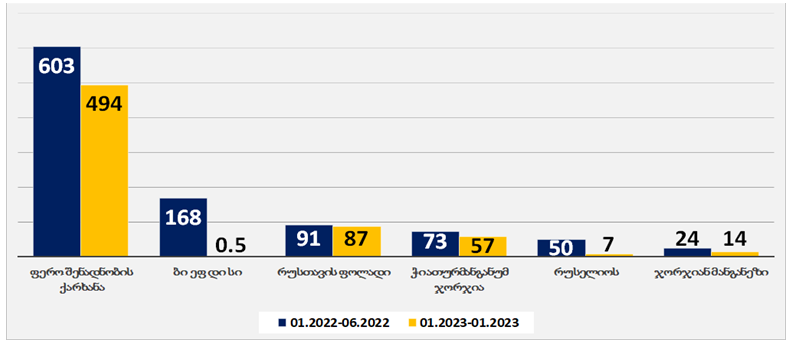Compared to the same period of the previous year, electricity consumption from January to June 2023 decreased by 10%, amounting to 6.575 billion kWh in Georgia. This decrease is largely attributed to a decline in electricity consumption among direct consumers, particularly large enterprises. Whilst these enterprises consumed two billion kWh of energy in the first half of 2022, their consumption shrank by 28% to 1.4 billion kWh in the first half of 2023. Electricity consumption has also declined in the occupied region of Abkhazia.
Concurrently with the global trend, energy consumption has been increasing every year, especially in developing countries. In 2011, Georgia's electricity consumption was 10.2 billion kWh, which rose to 11.6 billion kWh in 2016, and further increased to 14.2 billion kWh in 2022.
In the case of Georgia, occupied Abkhazia has significantly contributed to the overall growth rate. Despite having only 250,000 inhabitants and very limited production, mainly cryptocurrencies, occupied Abkhazia consumes more energy compared to Tbilisi, which has a population of 1.5 million. Additionally, energy consumption per capita in occupied Abkhazia exceeds that of Switzerland. This disparity is largely due to the availability of so-called "free energy," which is also consumed by cryptocurrency miners. Beyond occupied Abkhazia, consumption in other regions and companies is also rising, though at a slower rate.
In the first half of 2023, amidst a 7.6% economic growth rate, consumption by large enterprises decreased by almost one-third, constituting a significant drop by any measure.
Graph 1: Electricity Consumed by Direct Consumers (Million kWh)

Source: Electricity Market Operator (ESCO)
Reduction in crypto mining, coupled with a decrease in output from export-oriented, energy-intensive sectors, can be considered among the major factors contributing to the shrinking energy consumption. During January to June, exports from Georgia witnessed a 19% increase; however, local exports during the same period contracted by 22%. This implies that the growth in exports came at the cost of re-exports. The reduced demand for locally produced goods led to production cuts, subsequently resulting in a decline in electricity consumption.
In comparison to the corresponding period in the previous year, the first half of 2023 saw a significant decline in the export of copper ores, ferroalloys, and nitrogen fertilizers by 37%, 63%, and 41% respectively. Following the Bitcoin producing factory, BFDC (known as Bitfury), the largest reduction in energy consumption was observed in the ferroalloy plant. Russelios, which also specialises in producing ferroalloys, experienced a substantial percentage drop as well.
Graph 2: Consumed Electricity (Million kWh)

Source: Electricity Market Operator (ESCO)
In terms of volume, energy consumption decreased by 740 million kWh in the six months. Among that total, direct consumers accounted for 560 million kWh, whilst six major companies were responsible for 350 million kWh of that direct consumption.
Among these companies, BFCD (known as Bitfury), which was involved in cryptocurrency mining, experienced the most significant drop, amounting to 99.7%. Despite being situated in a free industrial zone and therefore exempt from paying VAT when purchasing energy, the company practically suspended its production this year. Bitfury began reducing energy consumption in June 2022 and had nearly reached zero by July. In 2021, Bitfury consumed 434 million kWh of energy, and in 2022, it consumed 171 million kWh (with 168 million kWh consumed in January-June). Given the example of BFCD, it's likely that other smaller companies also reduced or suspended their mining operations, which consequently impacted the overall statistics.
Energy consumption in occupied Abkhazia also decreased by 14%, dropping from 1.690 billion kWh to 1.450 billion kWh. In this case as well, the drop can be attributed to a reduction in Bitcoin production.
The consumption of other customers of EP Georgia Supply and TELMICO (referring to Energy Pro Georgia and TELAS) has seen a slight increase.
In 2023, no new large generation facility was put into use; however, reduced consumption facilitated export growth. In the first six months of 2022, around 620 million kWh of energy were exported, and in the first half of 2023, this figure rose to 756 million kWh. Despite the growth in terms of kWh, revenues from energy exports in the first six months of 2023 decreased by USD 1.2 million, amounting to USD 52 million. This trend changed in July; as of the first seven months of 2023, revenues from energy exports reached USD 80 million, which is USD 15 million more compared to the same period in the previous year.







